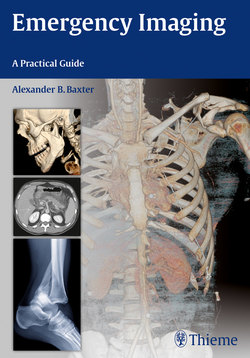Читать книгу Emergency Imaging - Alexander B. Baxter - Страница 99
На сайте Литреса книга снята с продажи.
Оглавление86Emergency Imaging
squamous cell carcinomas of the head and neck will be located in the PMS.
The parapharyngeal space (PPS) is im-portant not for what it contains, which is mainly fat and small blood vessels, but because it is easily identified by its low density and displaced by masses in the ad-jacent pharyngeal mucosal space, carotid space, masticator space, and retropharyn-geal space.
The retropharyngeal space (RPS) is a potential space containing lymph nodes located behind the dorsal PMS. It is an im-portant route of spread for infections of the PMS, including tonsillitis and periton-sillar abscess. Infections involving the RPS can arise by contiguous spread from adja-cent spaces and by suppuration of draining lymph nodes in the RPS. RPS infections can also extend inferiorly to the chest, leading to mediastinitis, a severe and potentially fatal condition.
The prevertebral space (PVS) is defined by the fascia that invests the vertebrae and prevertebral muscles. Infections and tu-mors located in the PVS usually arise from the disk or vertebral body. Because the PVS is contiguous with the epidural space, in-fection of the PVS can potentially lead to an epidural abscess.
The carotid space (CS) contains the ca-rotid artery, jugular vein, lymph nodes, the carotid body, and the ninth and tenth cranial nerves. Pathologies specific to this space include carotid body tumors, CN9 and CN10 schwannomas, vascular disease (arteritis and thrombophlebitis), and arte-rial injuries and anomalies including pseu-doaneurysms and arteriovenous fistula.
The parotid space (PS) surrounds the parotid gland, a number of lymph nodes, the proximal parotid duct, and the seventh cranial nerves. Parotitis, parotid sialadeni-tis, benign and malignant salivary gland tumors, lymphoepithelial cysts (seen in HIV-positive patients), and lymphadenitis occur here.
The masticator space (MS) contains portions of the mandible and the masse-ter, temporalis, and pterygoid muscles, as well as blood vessels and nerves. Most in-fections in this space are of dental origin. Neoplasms arising from muscle and bone can also occur in the MS.
reformations of head, face, and cervical spine. Images obtained from orbital roof to thoracic inlet.
Contrast: 60–100 mL at 3–4 mL/sec in arterial phase.
Temporal Bone CT
Indications: Skull base fracture, auditory or vestibular dysfunction, hemotympanum in trauma, mastoiditis, otitis media or externa.
Technique: 0.6-mm dataset with 0.6-mm axial, 1-mm sagittal, and 1-mm coronal reformations of the temporal bone in bone algorithm. Images obtained from petrous apex to C1.
Contrast (optional depending on indication): 60–100 mL at 3–4 mL/sec in venous phase (30–45-second delay).
Anatomy
Interpreting neck CT is aided by an un-derstanding of the various deep compart-ments that are separated by investing fascia. Because the dierential diagnosis of a neck mass depends primarily on its loca-tion, this approach is useful for establish-ing the likely nature of an inflammatory or neoplastic processes. These compartments include
• Pharyngeal mucosal space
• Parapharyngeal space
• Retropharyngeal space
• Pre- (or peri-) vertebral space
• Carotid space
• Parotid space
• Masticator space
• Submandibular space
• Sublingual space
Because the fascia investing each of these spaces acts as a barrier to the spread of infection and because each contains spe-cific tissues, locating a process to one space or another goes a long way toward making a diagnosis of head and neck disease.
The pharyngeal mucosal space (PMS) consists of the mucosa lining the upper aerodigestive tract and associate lymphatic tissues. Pharyngitis, tonsillitis, and most
